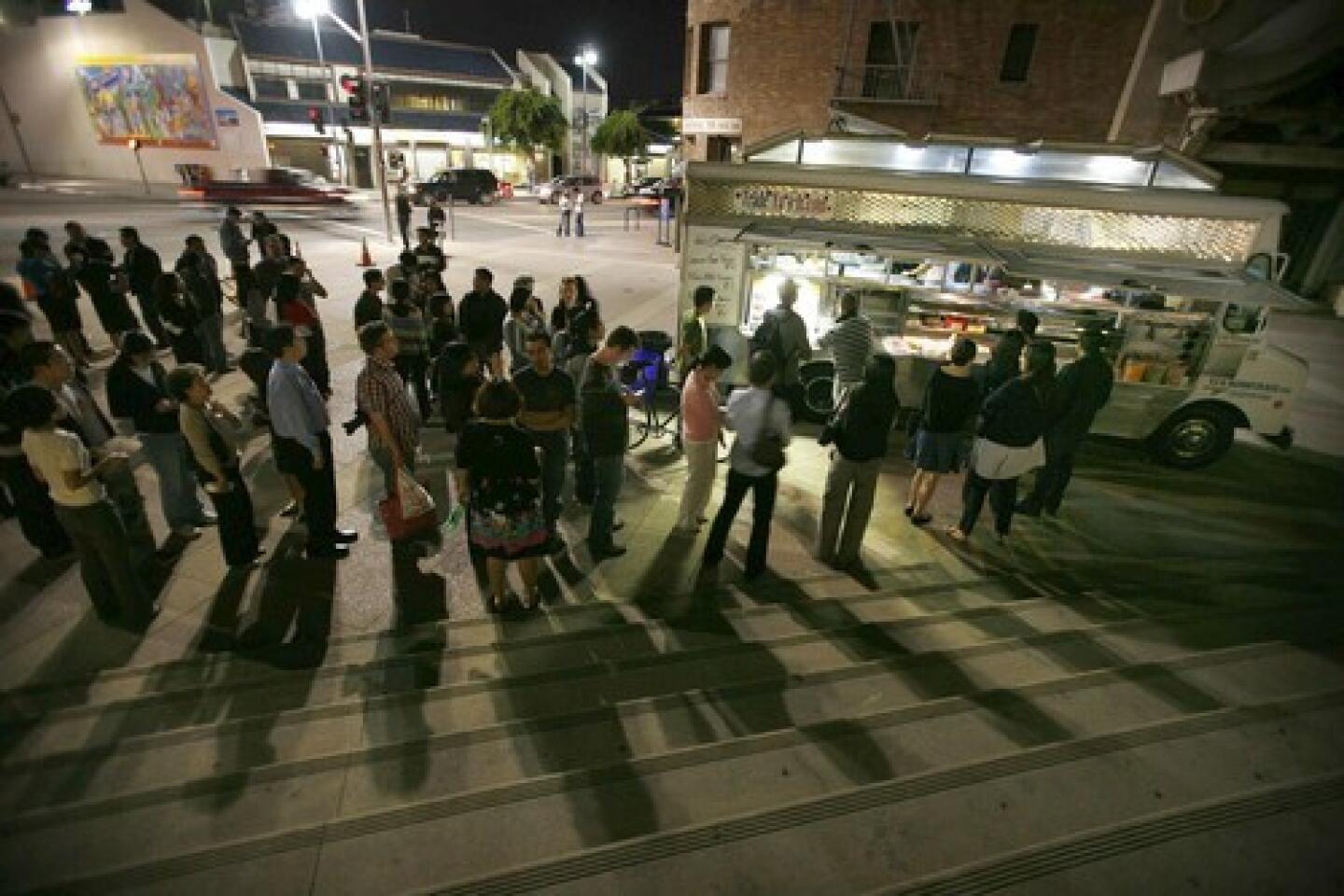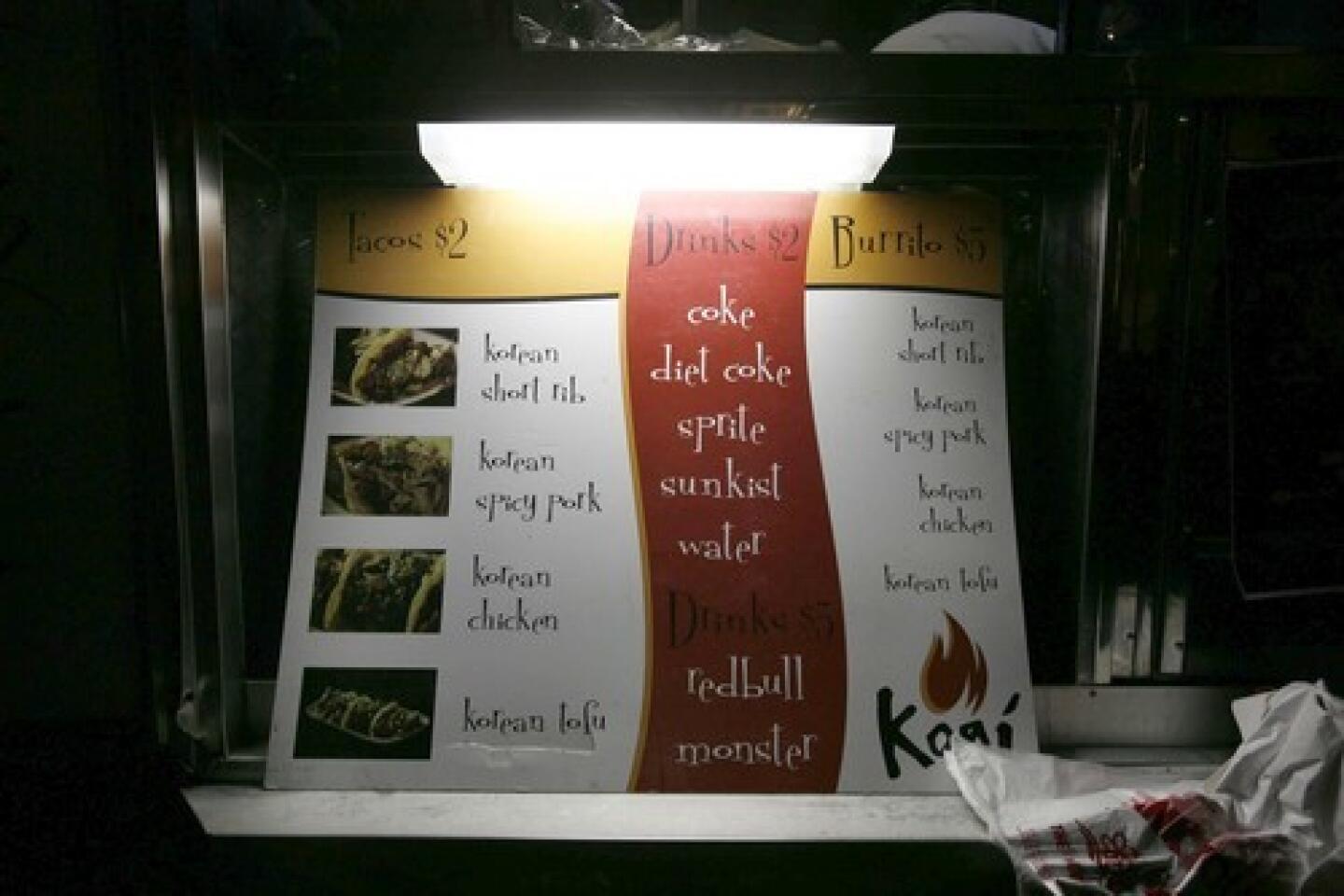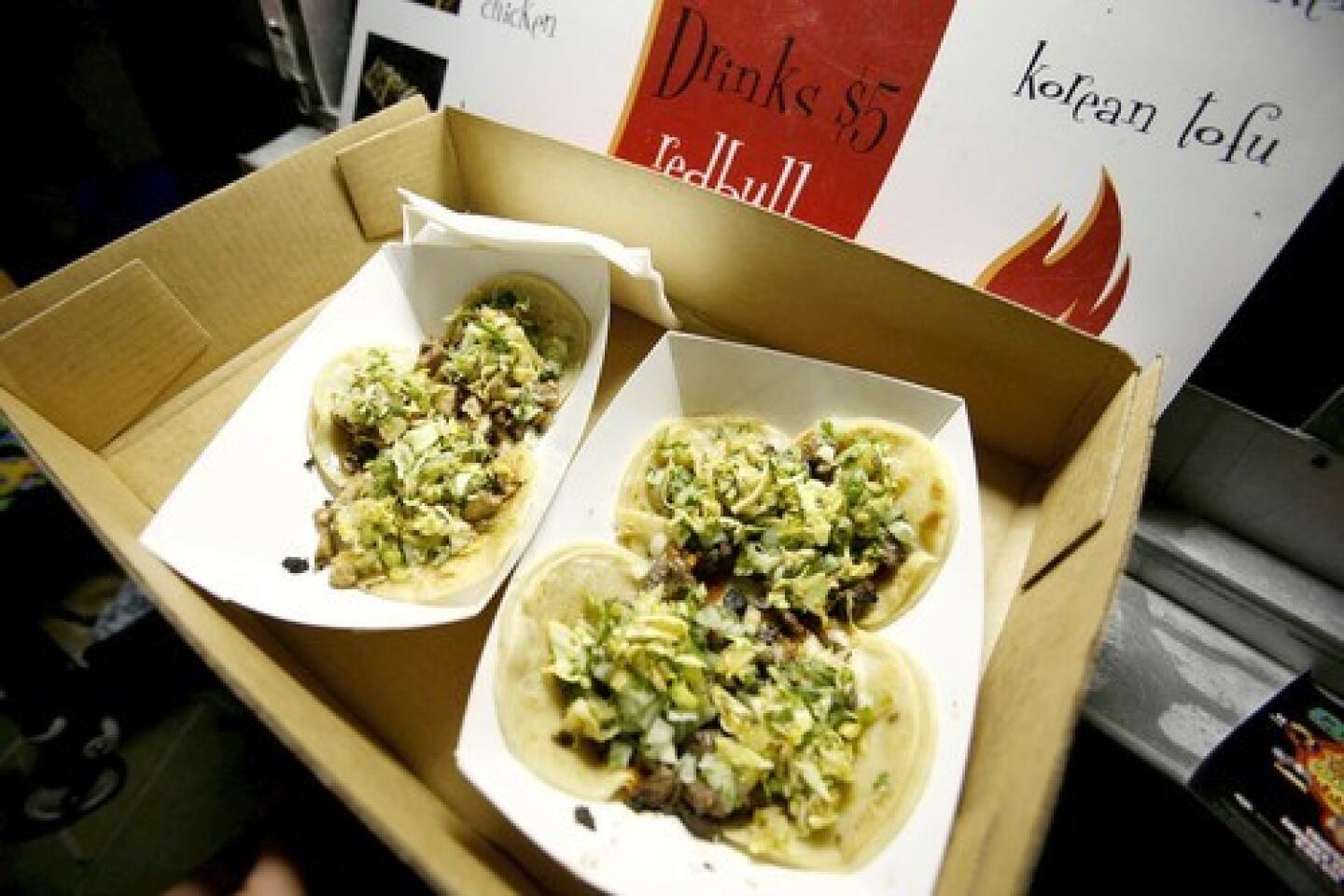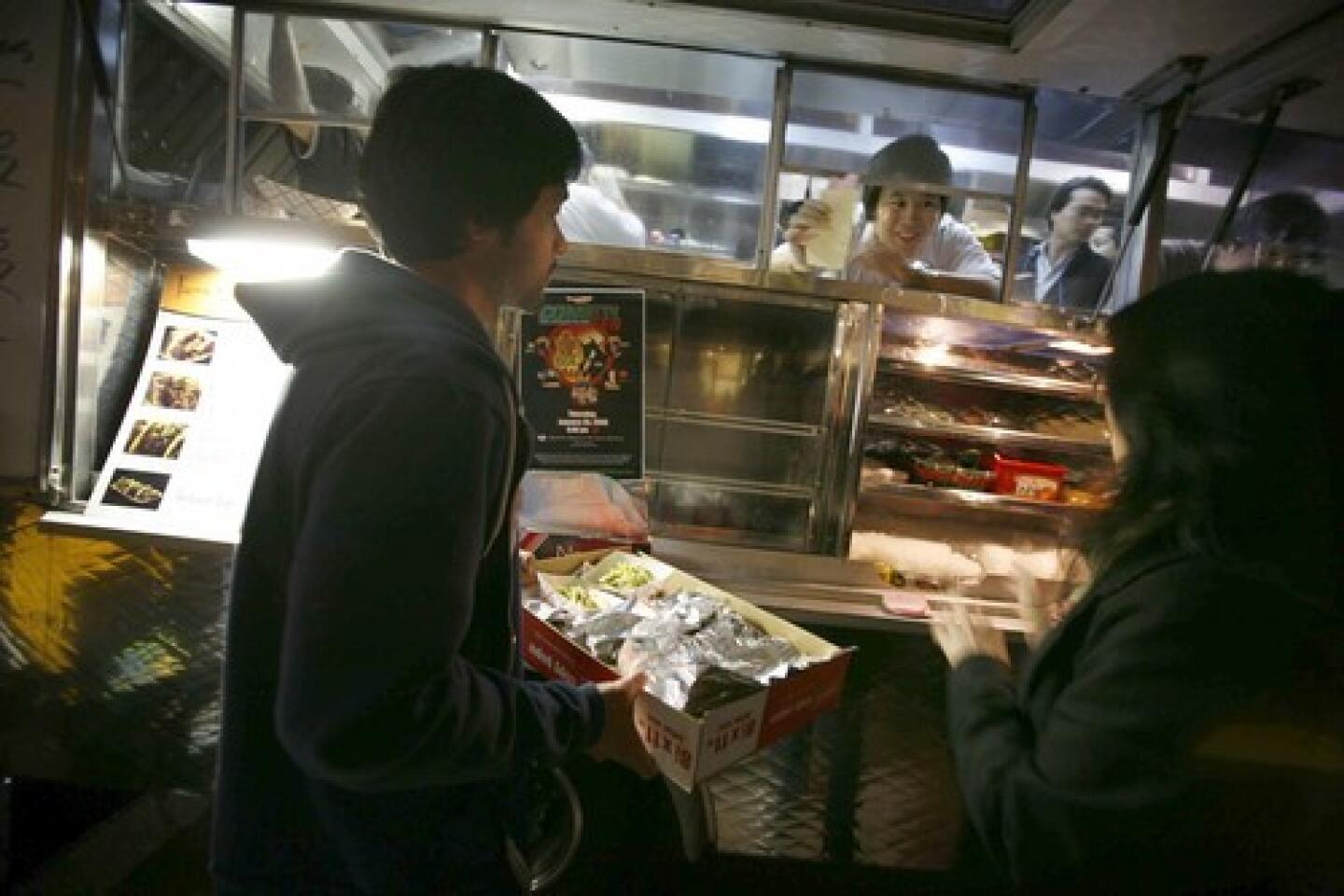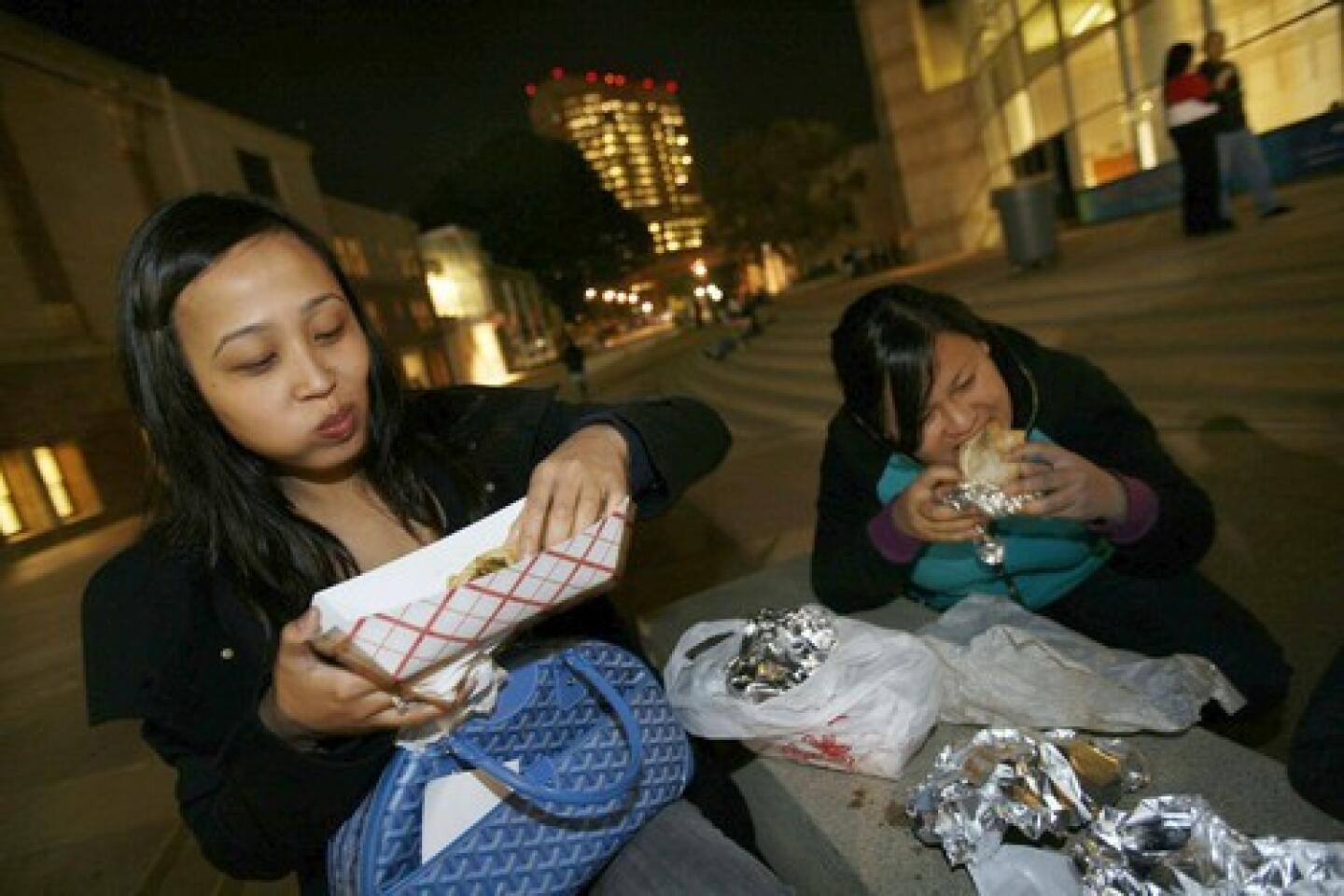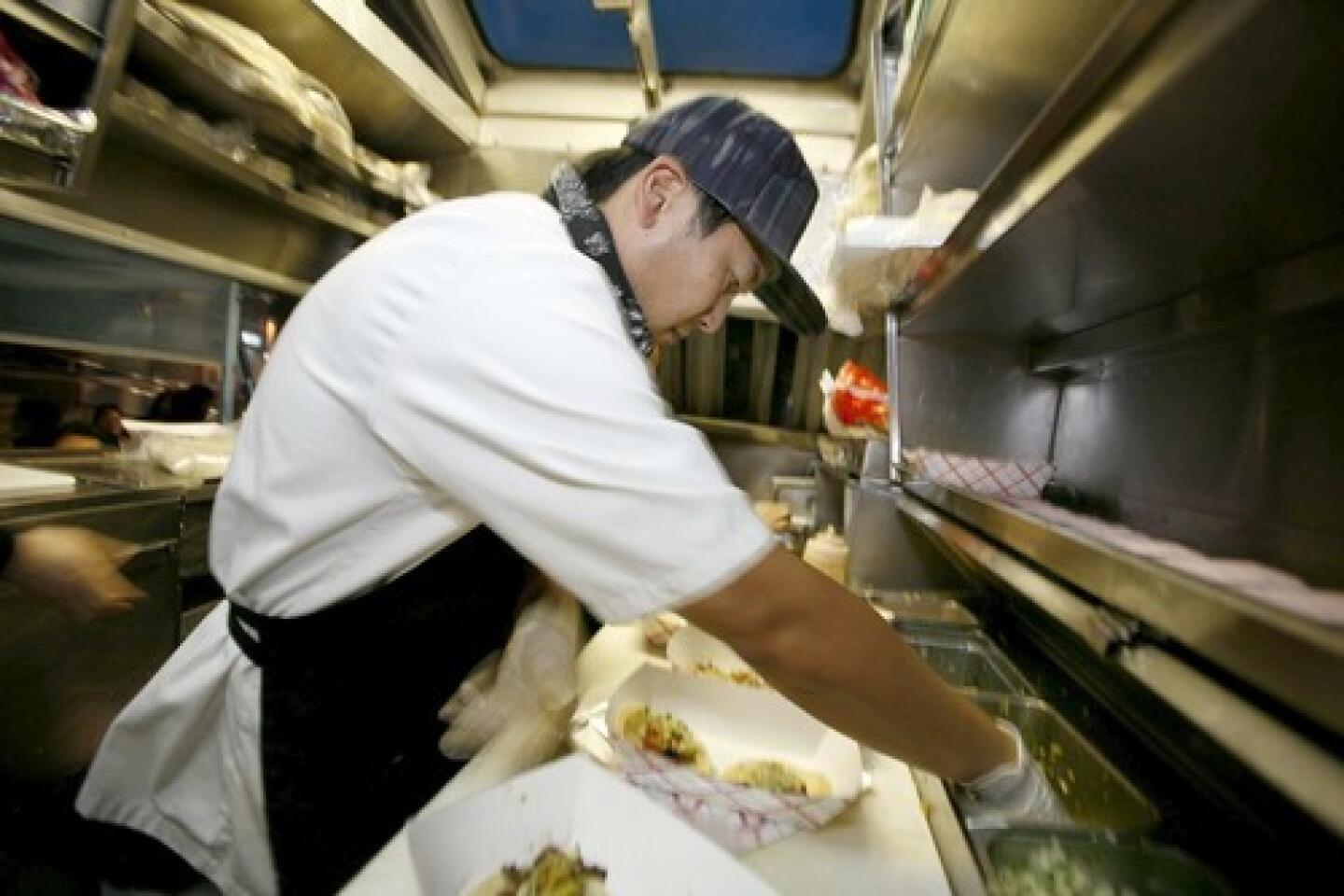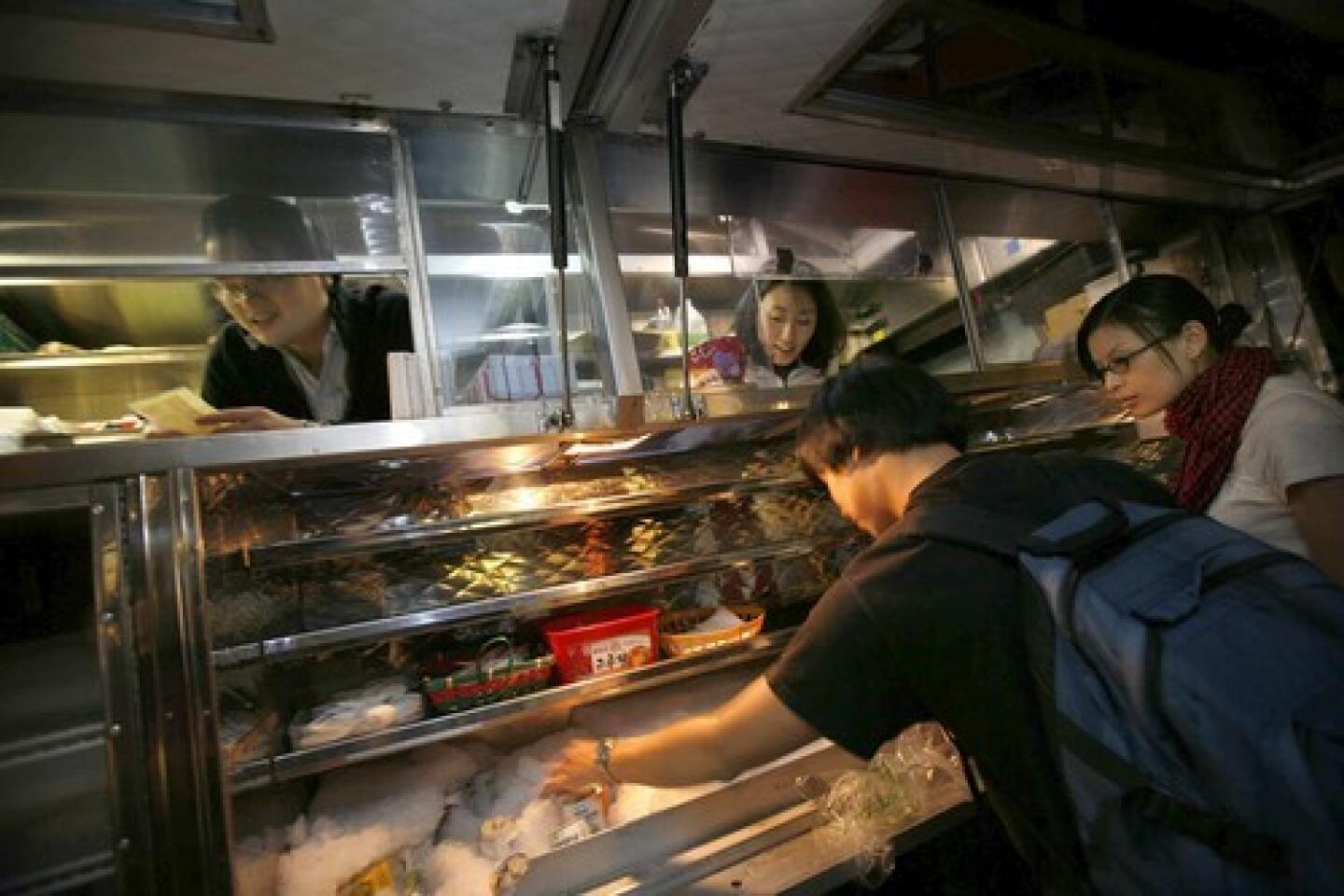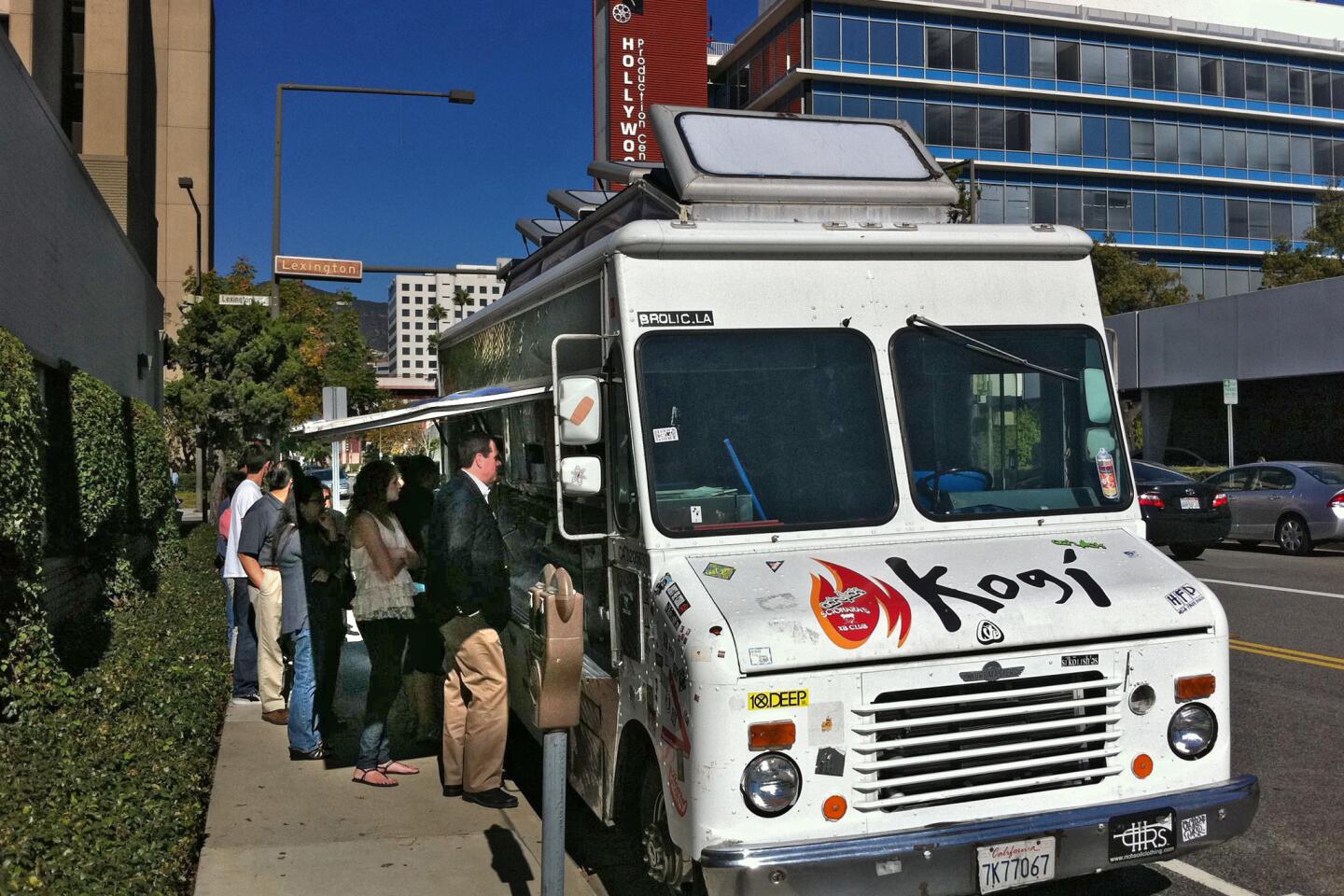Kogi Korean BBQ, a taco truck brought to you by Twitter
- Share via
It started with a 4 a.m. glass of Champagne and a carne asada taco after a night of serious bar hopping. Thirty-year-old Mark Manguera was sitting with his 25-year-old sister-in-law, Alice Shin (his wife Caroline was already sleeping soundly), when the taste of L.A.’s most ubiquitous street food caused him to have a drunken revelation.
“I’m biting into my taco and it dawned on me, ‘Alice, wouldn’t it be great if someone put Korean barbecue on a taco?,’ ” recalls Manguera, who is Filipino but married into a Korean family. Most people would have left it at that, maybe recounting their brilliant idea ad nauseum to friends at dinner parties, but Manguera followed through. He got a truck from taco-truck Goliath Cater Craft, he brought in former RockSugar chef Roy Choi as a partner, and he enlisted friends and family to begin blogging, branding and Twittering on his behalf.
The result: The Kogi Korean BBQ taco truck. (@kogibbq on Twitter) After celebrating a Nov. 20 soft opening, the roving vehicle has emerged as a social-networking juggernaut, drawing 300 to 800 people each time it parks (often several times in an evening) and spawning a burgeoning cyber-hippie movement affectionately referred to as “Kogi kulture.”
The truck and its staff of merry makers have become a sort of roving party, bringing people to neighborhoods they might not normally go to, and allowing for interactions with strangers they might not otherwise talk to. A constant Twitter feed connects truck-followers and updates them about whether Kogi is going to be late to its next stop. Occasionally, a negative Nelly will rain on this love parade by asking the Kogi truck to park elsewhere; when this happens, legions of Kogi-lytes rally to find a desirable new location.
On a recent Thursday night, Kogi (pronounced with a hard “g”) parked at 5:30 p.m. at the Japanese American National Museum on Central Avenue and 1st Street in Little Tokyo. By 7 p.m., the truck had already served at least 400 people and a long line still snaked across the broad brick entrance to the museum.
Nearby, DJ Akaider cranked dance music and reggaeton. Manguera says he asked Akaider to participate that evening out of appreciation for a YouTube video the DJ made about eating at Kogi called “Chasing the Dragon (The Kogi BBQ Adventure).” In the video (which has been viewed more than 2,000 times), Akaider is seen driving through Silver Lake trying to find the “elusive” Kogi truck. He eats a Korean hot dog with kimchi sauerkraut and takes a spicy pork taco home for his dad.
Those in the slow-moving line are appreciative of the musical distraction. Milady Flores and her friends Courtney Morofuji and Doug Wu stand near the front of the line. They have been waiting for an hour (by the time they get their tacos it will have been nearly two hours). They are giggling because a drunken girl has slipped them $10 to buy her three tacos. Tacos cost $2 each, so that’s a $4 profit for them (or two free tacos).
They don’t mind waiting, though. “If you’re expecting it, it’s OK,” Morofuji says. And it’s safe to say that pretty much everyone in line is expecting it.
L.A. phenom
So, how did this happen, and what kind of magic resides in a Kogi taco? Maybe it’s the power of juicy meat; flavored with slightly spicy, delicately tangy Korean “salsa roja,” topped with cilantro and onions as well as cabbage slaw with soy-sesame chili, and cupped in a soft corn tortilla, it can taste awfully good, especially when your stomach has spent two hours priming. Or perhaps it’s the exquisite cultural co-mingling inherent in the food that draws crowds; the only-in-L.A. combination of two of the city’s most beloved ethnic cuisines. Maybe it’s the thrill of being a part of the rogue movements and flash mobs created through the power of today’s many instantaneous modes of communication.
Sitting on the museum steps with his legs crossed and a diminutive Yorkshire terrier named Diesel in his lap, Manguera looks with bewilderment at the line in front of Kogi and offers this: “I have no idea how this happened.” Recently he’s been overwhelmed by a flash flood of investment solicitations, as well as many offers to cater high-profile special events and parties Beginning in about a week, Kogi will take over the kitchen at David Reiss’ Alibi Room, effectively establishing the brand’s first bricks-and-mortar location. Cedd Moses’ 213 group has expressed interest in accomplishing something similar with Kogi in downtown L.A.
“SBE called me yesterday,” Manguera says, referring to the entertainment group owned by the he-man of L.A. night life, Sam Nazarian, and adding, “I admire the guy. He’s brought in a group of people who know better than him, and that’s the key to good business. When they called, I was like, ‘Now I’m happy.’ ”
Manguera, too, has brought in a group of people who know better than him. By his own admission, he is not very tech-savvy. “The most I know about the online world is my Google mail and my MySpace,” he says. That’s where his sister-in-law Alice Shin comes in handy.
She blogs incessantly for Kogi using the upbeat, LOL-speak that drives online dialogue. Her post about the recent launch of a second Kogi truck reads: “KOGIHEADQUARTERSIS TOTALLYPREGGERSAND ISGIVINGBIRTHTOANEW BABYTRUCK . . . So I’m leaving it to YOU, the peopLes to nominate names for our trucks, because at this rate, Roy’s gonna be caLLing Big Brah KoGi #1 and Mark’s gonna be caLLing the new one KoGi #2, which, frankLy, is way BORING.” Names poured in from fans; an early favorite was “Kogi Juan Kenogi,” but the crew settled on the more prosaic Kogi Roja and Kogi Verde -- though they’re still not sure which truck will be which.
Shin also runs the truck’s Twitter feed, which, as it turns out, is a transnational endeavor. Because Kogi draws such massive crowds, it usually runs late. When that happens, Manguera calls Shin in Brooklyn, and Shin puts out a Twitter feed notifying those waiting of the truck’s delay.
Family affair
The other key players on the Kogi carousel? Manguera’s wife, Caroline, who as a food, beverage and hospitality specialist with Four Seasons hotels knows how to keep a crowd calm and make people feel special (she also knows how to keep Kogi’s books); Caroline’s brother Eric Shin, who obsessively photographs the truck’s cross-county journeys (from Rosemead to Westwood to Mid-Wilshire and more); Eric’s best friend Mike Prasad (another twentysomething social networking and branding wunderkind); Caroline’s cousin Young Ho Yoo, who acts as the truck’s promoter; and finally, 38-year-old chef Roy Choi himself, who sees his place in the group as that of culinary guru -- a sort of post-Abstract Expressionist food artist.
“This is my graffiti,” says Choi, who insists that up until now his life story (despite its many highs) has been one of failure. Born to Korean immigrant parents, Choi struggled to find his place, toying with law school before stumbling into the world of the palate. He worked in restaurants in New York and Palm Desert before being invited to work in the kitchen of “Iron Chef” Rokusaburo Michiba in Japan.
When Manguera contacted Choi he was at a crossroads, having left a cushy chef de cuisine job at the Beverly Hilton Hotel (where he cooked for then-Sen. Barack Obama, Bruce Springsteen and the royal family of Dubai) and most recently moving on after helping open RockSugar Pan Asian Kitchen in Century City.
“It’s not Korean food,” Choi says of Kogi. “It’s a Korean American kid translating the food from his country into the present-day life of L.A. It’s everything I see: the Latinos working in the Korean market, the bus that I ride.”
Choi introduces nightly specials to the menu (like the Venice Beach vegan black sesame seed jelly special, barbecue sliders and chorizo and egg tacos). Once people have waited in line, they tend to order a lot, pushing the average check near $20. When they finally sink their teeth into the much-hyped fare, are they disappointed?
For the most part, the answer is no (though many in line say they wouldn’t make it a habit). After a two-hour wait in Little Tokyo, Doug Wu and his friends walk away with a large bag. Wu stops to bite into a taco as his friends look on anxiously. Wu scrunches his face in displeasure. “This is disgusting,” he says. His friends look deflated, then he smiles broadly, juice dripping down his forearm. “Ha! No, it’s really good!”
More to Read
Sign up for The Wild
We’ll help you find the best places to hike, bike and run, as well as the perfect silent spots for meditation and yoga.
You may occasionally receive promotional content from the Los Angeles Times.
